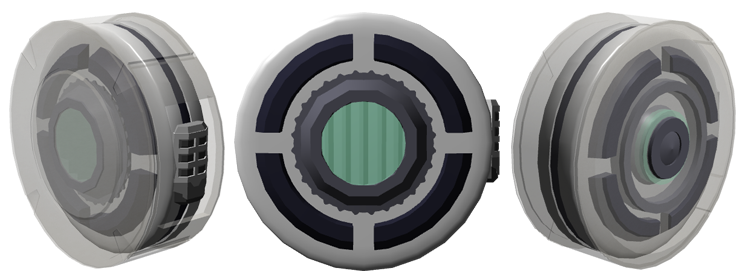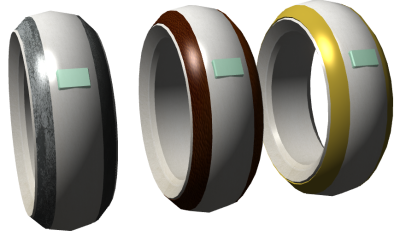Sidebar
Table of Contents
NH-M-M2 "Orchestra"
The Near Field Spatial Manipulator “Orchestra” is a device used to simulate a set of 'solar-system like' qualities around itself. The primary applications of this are holding objects in 'orbit' and changing the path of beam weaponry fired within the device's area of influence.
“With Orchestra by Noval, your world literally revolves around you!”
| Designer: | Noval Defense, Space, and Security |
| Nomenclature: | NH-M-M2 |
| Manufacturer: | Noval Heavy Industries |
| Fielded by: | Noval Heavy Industries, New Dusk Conclave |
| Availability: | Only as a component of existing products or from licensed retailers. |
History
During Noval's attempts to replicate a drive system similar to Yamatai's Combined Field System, the engineers instead found a way to alter the spatial properties of objects within a fixed radius from the new device. It seemed as though this spatial fixing even superseded the normal effects of gravity to an extent. The resulting device was similar in many ways to a micro-sized tractor beam projector, albeit one with a different approach.
As interest in the device grew, it quickly stopped being an object of curiosity and turned into a full research and development effort. The team dubbed the device the 'Orchestra' after one engineer programmed it to play the violin as a demo of the device's capabilities.
Design
An Orchestra appears as a simple ring comprised of four quarter-circle projectors oriented into two perpendicular pairs. The device does not need to be unobstructed except by materials that would otherwise impair electromagnetic radiation and, as such, it is typically concealed within armor or other components.
If sold as a standalone product, it will include its own casing. A sliding door on the casing allows access to input ports for power and control integrations.
A power cell or generator can be inserted and locked into place in the center of the ring using an included encasement. The encasement comes with a variety of fittings to support various manufacturer's power supplies, such as a HONEY DROP or PowerPak.
The Orchestra is designed to automatically modulate itself to adjust for a user's electromagnetic shields. This process can be made faster and more reliable by securely linking the two devices.
Function
The Orchestra device alters the curvature of space around nearby objects through a combination of gravitational waves and electromagnetic radiation. This change in curvature is oriented in respect to the Orchestra device itself and displays properties similar to a planet or star's ability to hold objects in their orbit and alter the course of energy with the force of its gravity.
Objects in the Orchestra's 'orbit' are typically held in a position similar to an object orbiting a planet. This is also known as “capturing” an object. When the device moves or rotates, it may take a moment for these captured objects to adjust to the change in acceleration and/or velocity before returning to their intended location. Captured objects can be relocated and/or have their orbit adjusted for a small energy expenditure. Typical orbit patterns are fixed (ie, geosynchronous) or rotating (periodic). An object can be put into an escape orbit, if desired.
Usage Considerations
The Orchestra can be used to grab objects with a strength based on its size and the amount of energy available to it. In practice, this means that it typically has a 'pull' about half as strong as the standard lifting capacity of the armor or craft it is equipped to. Once 'held', a captured object is effectively weightless until an outside force applies force to it. While weightless, the objects weight is transferred to the user, as though it were physically held.
If the Orchestra is used to capture an object that are too large or firmly attached, the user may instead be pulled closer to these objects. The Orchestra automatically treats such an object as a 'fixed' orbit to prevent the user from moving unexpectedly, but this can be changed afterwards. This makes the Orchestra useful for organics and objects that do not have a way to control their own gravity in Zero-G. Users should be aware that this is not a full gravity manipulation system and that it relies on nearby objects to function. If attempting a space walk, all appropriate safety equipment should still be worn.
The Orchestra's affect range is roughly twice the longest dimension of the armor or craft it is equipped to. Beyond this range, the amount of force it can apply to grab and hold captured objects falls off steeply.
In the event that multiple Orchestras are in use near to each other, an object remains under control of its current Orchestra unless the other Orchestra attempts to 'take hold' of it. In this case, the Orchestra with the greatest power and/or proximity to the object would 'win' control.
While fine manipulation of an object's position and rotation are possible, it cannot be used to perform fine manipulations on the object itself. In the original violin demo, the violin and bow were able to be sufficiently controlled, but additional objects had to play the role of each finger interacting with the violin's fingerboard.
Beam Bending
The trajectory of beam weaponry fired within the Orchestra's influence can be altered to some extent. By creating electromagnetic 'corridors' around the beam's origin point, the Orchestra can cause the beam to travel along a simple arc. While this affords the user some degree of defense against beam and energy weaponry, it should be considered as a supplement at best for a traditional electromagnetic shield. This feature is unavailable without a sophisticated external control system.
Operating the Orchestra requires an external control device. For basic use, an interface such as a datapad or the Orchestra Control Band™ is sufficient. For more intricate control of objects, a more powerful control system is required. The amount of objects that an Orchestra can hold is primarily limited by this external processing power and not by power constraints. When using an Orchestra for weapons and/or equipment management, the installed device should dictate the Orchestra's capacity in a manner similar to hard points.
Orchestra Tuned™ Accessories
An object designed to work with the Orchestra device may have additional special capabilities that take advantage of or enhance the Orchestra's functions. Such capabilities are detailed on the device or accessory itself.
Orchestra Control "Band Conductor™"
The Orchestra Control “Band Conductor™” (Conductor™, for short) appears to be a very well made finger ring. Available in a variety of high quality materials, designs, and colors, it is always pleasant to look at and eye catching. The Conductor™ can pair with other devices in a similar manner to a smart watch to act as an additional display and input device.
The Conductor™ features a miniature Galactic Horizon Volumetric Display Module that can create an interactive screen the size of a sheet of paper. This interface appears with a simple tap of the band and can control basic functions of the Orchestra, such as setting the orbit properties of an object. The interface can be held in front of an object within the Orchestra's range and 'tapped' on the screen to select it for capture. A user can double tap the Conductor™ to pull up a smaller display featuring a clock, calendar, and so forth. Other basic controls have similar touch commands on the Band Conductor™ itself.
Control can also be performed by voice and movement. A tutorial mode is available to help users adjust to this control setup.
To retrieve an object into the Orchestra's orbit, the user can point their open hand at an object within range and state “Capture” in a language that matches the Conductor™'s settings. The Orchestra will begin to pull the object towards the user's hand at a safe speed. Retrieval can be sped up by moving the user's hand backwards and slowed down by moving their hand forwards. When the user closes their hand, the object will enter orbit in its current position. An object entering into a user's hand is slowed to a safe speed before contact.
To release an object from the Orchestra's control, the user can point their open hand at an orbiting object and state “Release”. This causes the object to slowly drift away from the user. While releasing an object, the Orchestra will attempt to have the object follow the direction of the user's hand for as long as it remains open. In the event that an object reaches the Orchestra's control limit and does not have a place to be set down gently, the Orchestra will attempt to lower the object to the ground instead.
Additional voice commands include “Slower”, “Faster”, “Stop”, and “Rotate”. Commands such as “Rotate at 20% Speed” are also accepted.
The Band Conductor™ has been designed to function in a user friendly fashion. Thousands of interactions with the Band Conductor™, and the objects the Orchestra is controlling, have been tested and optimized to provide a safe, natural, and enjoyable experience.
For larger Orchestra systems, such as those found on a fighter craft, multiple Conductor™'s can share access to basic controls. A single Conductor™ can be paired to any number of Orchestra by direct pairing or through a user rights management system.
A power armor version, called the “Big Band Conductor™”, is available. It is similar in appearance, function, and control to the Band Conductor™. It's size has been increased to fit a power armor's finger, though it will function normally if it is attached anywhere on the hand.
The Big Band version is intended for utility and civilian purposes. For companies or factions with the means, Noval recommends a tighter integration with the armor's control systems to improve control and capacity.
Any damage caused by or to objects controlled by the Band Conductor™ and Big Band Conductor™ control systems are solely the responsibility of the user.
Virtual Hardpoint System
For objects that do not require a physical power connection and have a way to wirelessly receive commands, Orchestra can be used as a 'virtual' hardpoint system. These objects can be placed into orbit before a craft or power armor are deployed and held in a desired position for as long as is required.
When it comes time to change out or release the objects, Orchestra makes the process simple. With no physical connection to the craft/armor, exchanging objects is a simple procedure.
Statistics
The Orchestra is a device that allows users to 'hold' items without physically holding them on their person. While held, their position can be modified in various ways. The following are general usage and operating details.
- Size: Varies by Tier (Details)
- Lift Capacity: Up to half of the object/armor/craft's lifting capacity per 'Capture'
- Once an object is captured, the Orchestra can lift something else.
- If a user attempts to lift an object larger than this, they will instead find themselves pulled towards that object. Such an object cannot be held in 'orbit', but can be used as a physical anchor.
- Weight Capacity: Varies based on what it is used by
- The device transfers the total weight of what it is carrying to the object/armor/craft it is attached to.
- In other words, if an Orchestra were holding a twenty pound object for an individual in power armor, it would feel as though the power armor is still physically carrying it
- Power: The Orchestra device does not generate its own power.
- A dedicated power source, such as a HONEY reactor or PowerPak energy cell, of the appropriate size are recommended. It can also be powered via cable.
- The Orchestra comes with an adapter to fit a power source inside its center ring. When using an external power source, this central area is empty.
- Once an object is 'held', it requires very little power to maintain the warped space effect.
- Battery Life: Battery life varies based on the power source used and the size of the Orchestra. The following are estimates based on the use of a HONEY reactor. Strenuous use of the Orchestra, such as repeatedly capturing new objects or adjusting held objects, can reduce battery life by up to half.
- T1 - T3: 48 hours
- T4 - T6: One week
- T7 - T8: One week
- T9: One month
Availability
While sold primarily as a component of Noval products, consumer versions are available through licensed Noval sales partners.
All versions require an external power supply. Power supplies of the appropriate tier are recommended, such as a HONEY generator or PowerPak energy cell.
| Orchestra Tier/s | Price | Size |
| 1-3 | 6,000 DS (1500 KS) | 12 cm (about the size of a Compact Disc) x 2 cm |
| 4-6 | 12,000 DS (3000 KS) | 25 cm (about the size of a vinyl record) x 4 cm |
| 7-8 | 24,800 DS (6400 KS) | 45 cm x 7 cm |
| 9 | 60,000 DS (15000 KS) | 70 cm x 9 cm |
| Orchestra Tuned™ Products | Price | Size |
| Orchestra Control “Band Composer™” | 1,000 DS (250 KS) | Sold in all standard finger ring sizes |
| Orchestra Control “Big Band Composer™” | 2,800 DS (700 KS) | Sold in a variety of popular power armor finger sizes* |
*For non-civilian work, Noval recommends a direct integration instead of relying on a “Big Band Composer”, due to the various challenges involved in wearing a ring while in power armor.
OOC Notes
Whisper created this article on 2020/03/28 19:25.
Other fun techs with similar purposes or functions:
Attributions
- Character art created by pikisuperstar - www.freepik.com.
- Planets and other accessories created by freepik - www.freepik.com.
| Products & Items Database | |
|---|---|
| Product Categories | tools |
| Product Name | Orchestra |
| Nomenclature | NH-M-M2 |
| Manufacturer | Noval Heavy Industries |
| Year Released | YE 42 |
| Price (KS) | 1 ,500.00 KS |
Page Tools
Terms of Service - Privacy Policy





